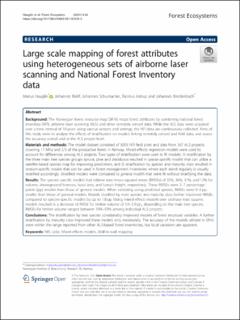| dc.description.abstract | Background The Norwegian forest resource map (SR16) maps forest attributes by combining national forest inventory (NFI), airborne laser scanning (ALS) and other remotely sensed data. While the ALS data were acquired over a time interval of 10 years using various sensors and settings, the NFI data are continuously collected. Aims of this study were to analyze the effects of stratification on models linking remotely sensed and field data, and assess the accuracy overall and at the ALS project level. Materials and methods The model dataset consisted of 9203 NFI field plots and data from 367 ALS projects, covering 17 Mha and 2/3 of the productive forest in Norway. Mixed-effects regression models were used to account for differences among ALS projects. Two types of stratification were used to fit models: 1) stratification by the three main tree species groups spruce, pine and deciduous resulted in species-specific models that can utilize a satellite-based species map for improving predictions, and 2) stratification by species and maturity class resulted in stratum-specific models that can be used in forest management inventories where each stand regularly is visually stratified accordingly. Stratified models were compared to general models that were fit without stratifying the data. Results The species-specific models had relative root-mean-squared errors (RMSEs) of 35%, 34%, 31%, and 12% for volume, aboveground biomass, basal area, and Lorey’s height, respectively. These RMSEs were 2–7 percentage points (pp) smaller than those of general models. When validating using predicted species, RMSEs were 0–4 pp. smaller than those of general models. Models stratified by main species and maturity class further improved RMSEs compared to species-specific models by up to 1.8 pp. Using mixed-effects models over ordinary least squares models resulted in a decrease of RMSE for timber volume of 1.0–3.9 pp., depending on the main tree species. RMSEs for timber volume ranged between 19%–59% among individual ALS projects. Conclusions The stratification by tree species considerably improved models of forest structural variables. A further stratification by maturity class improved these models only moderately. The accuracy of the models utilized in SR16 were within the range reported from other ALS-based forest inventories, but local variations are apparent. | en_US |

